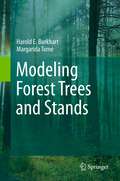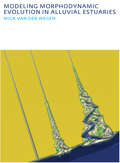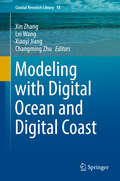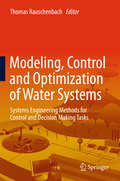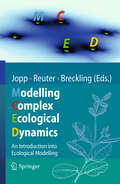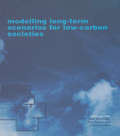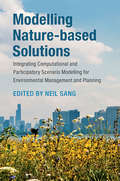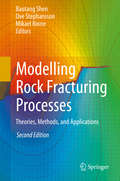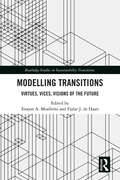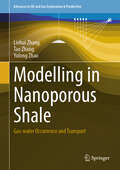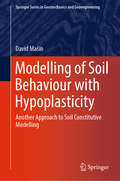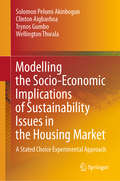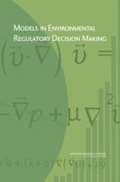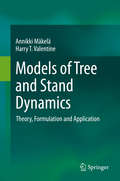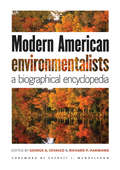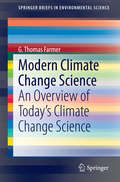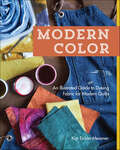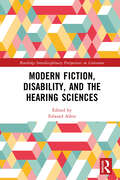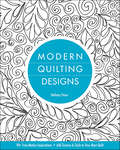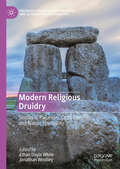- Table View
- List View
Modeling Forest Trees and Stands
by Harold E. Burkhart Margarida ToméDrawing upon a wealth of past research and results, this book provides a comprehensive summary of state-of-the-art methods for empirical modeling of forest trees and stands. It opens by describing methods for quantifying individual trees, progresses to a thorough coverage of whole-stand, size-class and individual-tree approaches for modeling forest stand dynamics, growth and yield, moves on to methods for incorporating response to silvicultural treatments and wood quality characteristics in forest growth and yield models, and concludes with a discussion on evaluating and implementing growth and yield models. Ideal for use in graduate-level forestry courses, this book also provides ready access to a plethora of reference material for researchers working in growth and yield modeling.
Modeling for Sustainable Management in Agriculture, Food and the Environment
by George VlontzosRecent developments in computer science, data mining and big data analytics have resulted in new operational frameworks in agriculture, food and the environment, which in fact, share a strong link between them. A key challenge for researchers is to extract new data patterns and utilize them in decision making. Managers, policy makers, and practitioners have to be aware of these methodologies in order to establish efficient and effective working groups for the tasks to be resolved. The book reviews the complexity of the interrelationship between agriculture, food production and processing, and environmental issues. It also highlights the prospects of modeling in various cases of problem solving in these sectors, and reviews the new and future challenges. Consumer awareness in food production and processing practices is continually increasing and the necessity for advanced behavioural tools follows the same trend. Furthermore, the value chain management challenge is becoming one of the most crucial tasks due to the increased importance of new parameters like the origin of products, its environmental footprint and the enhancement of local production, etc. The book addresses these topics in a holistic approach, merging modeling with advanced marketing practices in a coherent and innovative manner, being an effective tool in a continuously demanding world.
Modeling morphodynamic evolution in alluvial estuaries (IHE Delft PhD Thesis Series)
by Mick van WegenThe main objective of this research is to investigate the governing processes and characteristics that drive morphodynamic evolution in alluvial estuaries by application of a process-based numerical model (Delft3D). It is of utmost importance to understand estuarine processes so that impact of human interference (like dredging and land reclamation) and long-term changes (like sea level rise) can be evaluated.The research addresses a number of cases ranging from an rectangular basins to real estuaries like the Western Scheldt in the Netherlands or San Pablo Bay in California. The more schematized approach allow to study morphodynamic evolution over several millennia under constant forcing and answers more fundamental questions related to conditions of equilibrium and related time scales. The more realistic cases give insight into the skill of the approach in predicting decadal morphodynamic developments. More processes are included to mimic realistic conditions and model results are compared to bathymetric measurements over the last century.The research shows that the modeling approach is good capable of describing stable morphodynamic calculations over a timescale of millennia with patterns similar to patterns observed in reality. Additionally, the approach shows that it is possible to predict decadal morphodynamic developments in real estuaries with significant skill.
Modeling with Digital Ocean and Digital Coast
by Xin Zhang Xiaoyi Jiang Lei Wang Changming ZhuThis book presents essential new insights in research and applications concerning spatial information technologies and coastal disaster prevention modeling for oceanic and coastal regions. As a new research domain of Digital Earth, it covers the latest scientific and technical advances, from the acquisition and integration of observational data, ocean spatio-temporal analysis and coastal flood forecasting to frequency modeling and the development of technical platforms. The individual chapters will be of interest to specialists in oceanic and coastal monitoring and management who deal with aspects of data integration, sharing, visualization, and spatio-temporal analysis from a Digital Earth perspective.
Modeling, Control and Optimization of Water Systems
by Thomas RauschenbachThis book provides essential background knowledge on the development of model-based real-world solutions in the field of control and decision making for water systems. It presents system engineering methods for modelling surface water and groundwater resources as well as water transportation systems (rivers, channels and pipelines). The models in turn provide information on both the water quantity (flow rates, water levels) of surface water and groundwater and on water quality. In addition, methods for modelling and predicting water demand are described. Sample applications of the models are presented, such as a water allocation decision support system for semi-arid regions, a multiple-criteria control model for run-of-river hydropower plants, and a supply network simulation for public services.
Modelling Complex Ecological Dynamics
by Donald Deangelis Hauke Reuter Broder Breckling Melanie Trexler Sven Erik Jørgensen Fred JoppModel development is of vital importance for understanding and management of ecological processes. Identifying the complex relationships between ecological patterns and processes is a crucial task. Ecological modelling--both qualitatively and quantitatively--plays a vital role in analysing ecological phenomena and for ecological theory. This textbook provides a unique overview of modelling approaches. Representing the state-of-the-art in modern ecology, it shows how to construct and work with various different model types. It introduces the background of each approach and its application in ecology. Differential equations, matrix approaches, individual-based models and many other relevant modelling techniques are explained and demonstrated with their use. The authors provide links to software tools and course materials. With chapters written by leading specialists, "Modelling Complex Ecological Dynamics" is an essential contribution to expand the qualification of students, teachers and scientists alike.
Modelling Long-term Scenarios for Low Carbon Societies
by Junichi Fujino Neil Strachan Tim FoxonWith the ever-increasing impacts of climate change, it is now clear that global society will have to restructure its energy systems in order to decrease carbon emissions. The scenarios under which this transition to low-carbon societies (LCS) could occur would have complex economic, technological, behavioural and policy implications. This volume, a supplement to the Climate Policy journal, considers these implications by examining different low-carbon scenarios for different countries, modelled at different scales and typologies. Two overview chapters, co-written by international experts, set the context of scenario development and quantification of LCS, and summarize the findings on the economic implications, societal responses, technological developments and required policy measures to enable LCS across a range of countries. Further chapters detail the modelling of various scenarios and outline the model methodology, detail the economic and technological consequences of transitions to LCS, and comment on the strengths and weaknesses of specific policies.
Modelling Nature-based Solutions: Integrating Computational and Participatory Scenario Modelling for Environmental Management and Planning
by Neil SangNature-based solutions (NBS) are essential to ensure a sustainable society and healthy ecosystem over the coming decades. However, the systems to be managed are both broad and complex, requiring an integrated understanding of both bio-physical systems, such as soils and water, and economic and social systems, such as urban development and human behaviour. This edited book joins these domains of knowledge together from an applied perspective and considers how computer science can help. It takes a strategic look at the benefits and barriers to using modelling within environmental management and planning practice. It delves further by providing an in-depth comparative review of a wide range of models from a variety of scientific disciplines of interest with examples of their use for NBS. As such, this illustrated guide is designed to help students, researchers and practitioners navigate the huge range of modelling options available and develop the common understanding to work inter-disciplinarily.
Modelling Rock Fracturing Processes: Theories, Methods, and Applications
by Baotang Shen Ove Stephansson Mikael RinneThis book is the second edition of the well-known textbook Modelling Rock Fracturing Processes. The new and extended edition provides the theoretical background of rock fracture mechanics used for modelling of 2-D and 3-D geomechanics problems and processes. Fundamentals of rock fracture mechanics integrated with experimental studies of rock fracturing processes are highlighted. The computer programs FRACOD 2D and 3D are used to analyse fracture initiation and propagation for the three fracture modes: Mode I, II and III. Coupled fracture modelling with other continuous and distinct element codes including FLAC, PFC, RFPA, TOUGH are also described. A series of applications of fracture modelling with importance for modern society is presented and discussed by distinguished rock fracture modelling experts.
Modelling Transitions: Virtues, Vices, Visions of the Future (Routledge Studies in Sustainability Transitions)
by Enayat A. Moallemi Fjalar J. de HaanModelling Transitions shows what computational, formal and data-driven approaches can and could mean for sustainability transitions research, presenting the state-of-the-art and exploring what lies beyond. Featuring contributions from many well-known authors, this book presents the various benefits of modelling for transitions research. More than just taking stock, it also critically examines what modelling of transformative change means and could mean for transitions research and for other disciplines that study societal changes. This includes identifying a variety of approaches currently not part of the portfolios of transitions modellers. Far from only singing praise, critical methodological and philosophical introspection are key aspects of this important book. This book speaks to modellers and non-modellers alike who value the development of robust knowledge on transitions to sustainability, including colleagues in congenial fields. Be they students, researchers or practitioners, everyone interested in transitions should find this book relevant as reference, resource and guide.
Modelling in Nanoporous Shale: Gas-water Occurrence and Transport (Advances in Oil and Gas Exploration & Production)
by Tao Zhang Liehui Zhang Yulong ZhaoThis book addresses the problems involved in the modelling and simulation of shale gas reservoirs at pore scale, and details recent advances in the field. It presents the construction of simulation methods, mainly using the lattice Boltzmann method (LBM), that describe sorption, flow, and transport in nanoporous shale with some case studies. This book highlights the nanoscale effects, ascribed to the large surface-to-volume ratio, on fluids occurrence and transport physics. It discusses some interesting phenomena occurs at nanoporous shale, such as absorbed water film, water condensation, sorption hysteresis, surface excess adsorption, Knudsen diffusion, surface diffusion, structural fluid density, no-slip boundary, etc. The key techniques and methods introduced in this book provide the basis for accurate prediction of gas-well productivity. The basic principles and modeling methods are also relevant to many other nanoporous applications in science and engineering. The book aims to provide a valuable reference resource for researchers and professional scientists and engineers working on shale gas development and nanoporous media research.
Modelling of Hydrological Processes in the Narew Catchment
by Dorota Świątek Tomasz OkruszkoSince climate and land use strongly affect the runoff pattern and intensity of solute export, it is likely that some observations and conclusions formulated on the basis of investigations carried out in forested catchment may not be fully adequate to describe controls on solute export from agricultural watersheds. The primary objective of the present research is to better understand the flow paths that affect the fluxes of dissolved compounds from a small agricultural catchment during snowmelt. This book focuses on spring snowmelt, because this is the dominant hydrological event in many moderate and high latitude catchments and, thus, is regarded as a prominent factor influencing the quality of surface waters
Modelling of Soil Behaviour with Hypoplasticity: Another Approach to Soil Constitutive Modelling (Springer Series in Geomechanics and Geoengineering)
by David Mašín<p>This book explains the hypoplastic modelling framework. It is divided into two parts, the first of which is devoted to principles of hypoplasticity. First, the basic features of soil’s mechanical behaviour are introduced, namely non-linearity and asymptotic properties. These features are then incorporated into simple one-dimensional hypoplastic equations for compression and shear. Subsequently, a hypoplastic equivalent of the Modified Cam-Clay model is developed in 2D space using stress and strain invariants to demonstrate key similarities and differences between elasto-plastic and hypoplastic formulations. Lastly, the mathematical structure of hypoplastic models is explained by tracing their historical development, from the early trial-and-error models to more recent approaches. In turn, Part II introduces specific hypoplastic models for soils. First, two reference models for sand and clay are defined. After summarising their mathematical formulations, calibration procedures are described and discussed. Subsequently, more advanced modelling approaches are covered: the intergranular strain concept incorporating the effects of small strain stiffness and cyclic loading, viscohypoplasticity for predicting rate effects, soil structure to represent structured and bonded materials and soil anisotropy. The book concludes with a description of partial saturation and thermal effects: topics that are increasingly important to the disciplines of energy and environmental geotechnics. <p>Selecting a constitutive model and its parameters is often the most important and yet challenging part of any numerical analysis in geotechnical engineering. Hypoplasticity involves a specific class of soil constitutive models, which are described in detail here. The book offers an essential resource, both for model users who need a more advanced model for their geotechnical calculations and are mainly interested in parameter calibration procedures, and for model developers who are seeking a comprehensive understanding of the mathematical structure of hypoplasticity.</p>
Modelling the Socio-Economic Implications of Sustainability Issues in the Housing Market: A Stated Choice Experimental Approach
by Clinton Aigbavboa Wellington Thwala Solomon Pelumi Akinbogun Trynos GumboThis book discusses sustainable housing issues in urban areas throughout the Global South, revealing their complexity in terms of urban dynamics, housing markets and human interactions with the environment. Its main focus is on the location of graves within private residences, cemeteries in the immediate vicinity of private residences, and the implications of these factors for renters’ choices and rents. The book addresses the economics of land use for graves in connection with housing choices and the implications for the rented sector of the property market. By means of several model-based simulations, it demonstrates that the neoclassical economics remedy to the negative externality of graves in or near private residences remains generally unacceptable. Providing readers with a clear understanding of tenants’ priorities in their choice of housing, as well as a new approach to the negative externality of graves in the rented sector, the book will be of interest to policymakers, urban planners, investors in residential housing and land economists alike.
Models in Environmental Regulatory Decision Making
by National Research Council of the National AcademiesMany regulations issued by the U.S. Environmental Protection Agency (EPA) are based on the results of computer models. Models help EPA explain environmental phenomena in settings where direct observations are limited or unavailable, and anticipate the effects of agency policies on the environment, human health and the economy. Given the critical role played by models, the EPA asked the National Research Council to assess scientific issues related to the agency's selection and use of models in its decisions. The book recommends a series of guidelines and principles for improving agency models and decision-making processes. The centerpiece of the book's recommended vision is a life-cycle approach to model evaluation which includes peer review, corroboration of results, and other activities. This will enhance the agency's ability to respond to requirements from a 2001 law on information quality and improve policy development and implementation.
Models of Tree and Stand Dynamics: Theory, Formulation and Application
by Harry T. Valentine Annikki MäkeläThe book is designed to be a textbook for university students (MSc-PhD level) and a reference for researchers and practitioners. It is an introduction to dynamic modelling of forest growth based on ecological theory but aiming for practical applications for forest management under environmental change. It is largely based on the work and research findings of the authors, but it also covers a wide range of literature relevant to process-based forest modelling in general. The models presented in the book also serve as tools for research and can be elaborated further as new research findings emerge. The material in the book is arranged such that the student starts from basic concepts and formulations, then moves towards more advanced theories and methods, finally learning about parameter estimation, model testing, and practical application. Exercises with solutions and hands-on R-code are provided to help the student digest the concepts and become proficient with the methods. The book should be useful for both forest ecologists who want to become modellers, and for applied mathematicians who want to learn about forest ecology. The basic concepts and theory are formulated in the first four chapters, including a review of traditional descriptive forest models, basic concepts of carbon balance modelling applied to trees, and theories and models of tree and forest structure. Chapter 5 provides a synthesis in the form of a core model which is further elaborated and applied in the subsequent chapters. The more advanced theories and methods in Chapters 6 and 7 comprise aspects of competition through tree interactions, and eco-evolutionary modelling, including optimisation and game theory, a topical and fast developing area of ecological modelling under climate change. Chapters 8 and 9 are devoted to parameter estimation and model calibration, showing how empirical and process-based methods and related data sources can be bridged to provide reliable predictions. Chapter 10 demonstrates some practical applications and possible future development paths of the approach. The approach in this book is unique in that the models presented are based on ecological theory and research findings, yet sufficiently simple in structure to lend themselves readily to practical application, such as regional estimates of harvest potential, or satellite-based monitoring of growth. The applicability is also related to the objective of bridging empirical and process-based approaches through data assimilation methods that combine research-based ecological measurements with standard forestry data. Importantly, the ecological basis means that it is possible to build on the existing models to advance the approach as new research findings become available.
Modern American Environmentalists: A Biographical Encyclopedia
by George A. Cevasco Richard P. HarmondModern American Environmentalists profiles the lives and contributions of nearly 140 major figures during the twentieth-century environmental movement. Included are iconic environmentalists such as Rachel Carson, E. O. Wilson, Gifford Pinchot, and Al Gore, and important but less expected names, including John Steinbeck and Allen Ginsberg. The entries recount how each individual became active in environmental conservation, detail his or her significant contributions, trace the influence of each on future efforts, and discuss the person's legacy. The individuals selected for the book displayed either an unparalleled commitment to the conservation, preservation, restoration, and enhancement of the natural environment or made a major contribution to the growth of environmentalism during its first century. With a foreword by environmental historian Everett I. Mendolsohn, a time line of key environmental events, a bibliography of groundbreaking works, and an index organized by specialization, this biographical encyclopedia is a handy and complete guide to the major people involved in the modern American environmental movement.
Modern Climate Change Science
by G. Thomas FarmerComposed of two extensive sections, this book surveys important work in climate change science, mainly in the United States, and introduces contributions to the body of science that have arrived on the scene between January 2013 and February 2014. The opening section offers a broad examination of contemporary climate change science, with subsections on the Intergovernmental Panel on Climate Change (IPCC); Earth's energy imbalance and energy flow; carbon dioxide's role in the greenhouse effect; climate forcing, and climate feedbacks; Charles David Keeling and the Keeling Curve; the interfaces of atmosphere with oceans and land; paleoclimates and paleoclimatology; rising sea level; melting glaciers; deforestation; desertification; more violent storms, animal and human migration, extinction of species and more. The second section reviews and assesses the newest contributions to the body of research. Among the topics discussed are current and recent research on rising temperatures; the BEST study; the Global Historical Climatology Network (GHCN) and the National Climatic Data Center (NCDC); current and recent research on climate models, new research on global warming 56 million years ago; ecosystem impacts, projections of future climate and more. This book can be considered a bridge between the volumes of Farmer and Cook's Climate Change Science: A Modern Synthesis, as it arrives between the release of the first volume on the Physical Climate (2013) the second, on Earth's climate history, which is now in preparation. The book benefits a wide audience as its survey of the science of climate change provides an introduction to the subject and a discussion of current research in the field. The book may be used as a refresher for those who have had prior courses in climate science and related fields. Each chapter includes a comprehensive list of references for subjects discussed in the text.
Modern Color: An Illustrated Guide to Dyeing Fabric for Modern Quilts
by Kim Eichler-MessmerCreate a one-of-a-kind quilt with hand-dyed fabrics • Learn how to dye fabrics expertly using simple recipes for stunning effects • Features 9 modern quilted projects - in multiple colorways - showcasing the beauty of hand-dyed fabrics • Learn how to create a truly individual quilt for which you’re the fabric designer, quilt designer, and quiltmaker Go ahead - take a dip. This DIY book teaches you how to dye cloth by hand to create unique fabrics to use in modern quilt designs. Includes instructions for setting up a home dye studio with minimal equipment and teaches key mixing techniques. You’ll be able to make any color you want, including any value (lightness and darkness) and gradation, allowing for an unlimited palette and endless inspiration.
Modern Fiction, Disability, and the Hearing Sciences (Routledge Interdisciplinary Perspectives on Literature)
by Edward AllenThe relationship between critical disability studies and the hearing sciences is a dynamic one, and it’s changing still, both as clinicians come to terms with the evolving health of deaf and hearing communities and as the ‘social’ and ‘medical’ understandings of disability continue to gain traction among different groups. What might a ‘cultural’ approach to these overlapping areas of study involve? And what could narrative prose in particular have to tell us that other sources haven’t sensed?At a time when visual media otherwise seem to have captured the imagination, Modern Fiction, Disability, and the Hearing Sciences makes the case for a wide range of literature. In doing so – through serials, short stories, circadian fiction, narrative history, morality tales, whodunits, Bildungsromane, life-writing, the Great American Novel – the book reveals the diverse ways in which writers have plotted and voiced experiences of hearing, from the nineteenth century to the present day.
Modern Lumberjacking: Felling Trees, Using the Right Tools, and Observing Vital Safety Techniques
by Len McDougallTimber! Learn how to wield a chainsaw safely-and other lumberjacking skills.While the lumberjack look may be trending among the fashion-forward crowd, lumberjacking is a useful real-world skill. An amateur with a chainsaw or an ax is dangerous to both people and property. Fortunately, experienced woodsman and outdoor writer Len McDougall shares his thorough knowledge of how to fell trees the right way-safely-with the use of a chainsaw, handsaw, hatchet, and ax in Modern Lumberjacking.In addition to providing tips for bringing trees down, he also includes information on:Wood identificationHow to buck logs properlyHow to stack and age logsLumberjacking knotsAnd more!Because safety is a priority, McDougall provides color photos and detailed line drawings throughout to carefully illustrate his instructions and make his advice easy to follow. Modern Lumberjacking is the perfect resource for do-it-yourselfers, landowners, and outdoor enthusiasts who want to fell trees safely and protect themselves and their property.Skyhorse Publishing, as well as our Sports Publishing imprint, is proud to publish a broad range of books for readers interested in sports-books about baseball, pro football, college football, pro and college basketball, hockey, or soccer, we have a book about your sport or your team.In addition to books on popular team sports, we also publish books for a wide variety of athletes and sports enthusiasts, including books on running, cycling, horseback riding, swimming, tennis, martial arts, golf, camping, hiking, aviation, boating, and so much more. While not every title we publish becomes a New York Times bestseller or a national bestseller, we are committed to publishing books on subjects that are sometimes overlooked by other publishers and to authors whose work might not otherwise find a home.
Modern Quilting Designs: 90+ Free-Motion Inspirations, Add Texture & Style to Your Next Quilt
by Bethany Nicole PeaseStep out of stippling Be fearless with your free-motion quilting! This intermediate-level guide is filled with modern designs inspired by the world around us. Pebbles, waves, vines, and finials are just a few of the things you'll find in Bethany's hip and doodly quilting designs. You'll also learn how to spot interesting patterns everywhere you look to translate into your quilting. • Over 90 unique quilting designs for borders, blocks, and fillers-many are continuous-line • Fun, freeform shapes and lines give an imaginative spark to any quilt • Quilting diagrams show you how to put designs together for the most creative effect
Modern Religious Druidry: Studies in Paganism, Celtic Identity, and Nature Spirituality (Palgrave Studies in New Religions and Alternative Spiritualities)
by Ethan Doyle White Jonathan WoolleyOver the past three decades, the academic study of modern Paganism has gone from strength to strength. Scholars now have access to a plethora of studies available on such new religions as Wicca, Heathenry, and the Goddess Movement - but despite its prominence, modern Druidry has been much neglected. This book seeks to change that. This volume is interdisciplinary in basis, bringing together contributions from anthropologists, historians, and scholars of religion. It fundamentally deepens collective scholastic understandings of modern religious Druidry as an actor within the broader Pagan milieu. In addition to looking at the movement in various national contexts, the volume also explores thematic topics that have largely been neglected before. It will serve as a benchmark upon which all future studies of modern Druidry, as well as modern Paganism more widely, can draw upon, thereby making a particularly important and much-needed contribution to the field.
Modern Rock and Ice Climbing
by Bill BirkettThis book introduces the world of rock and ice, and details essential climbing techniques and equipment. It comprises fundamental units which can be used independently or combined to provide a comprehensive overall picture. With due consideration given to the extreme standards in modern climbing and the intense physical and mental preparation necessary, there is separate coverage of both safety and performance.
Modern Rockhounding and Prospecting Handbook
by Garret RomaineThis volume gives you the basic tools to transition from &“pebble pup&” to expert rockhound and explains everything from geology basics, identification tips, tools of the trade, how to record your findings, and how to set up a lab or gem shop. Before you know it, you&’ll be driving the open roads and traveling home with dusty pockets full of rocks, gems, minerals, fossils—and maybe even gold.Features:* geology basics* popular collectibles, including rocks, gems, fossils, meteorites, and gold* tools of the trade for every level of collector* rules and regulations* polishing, preserving, crafting, and displaying your treasures
